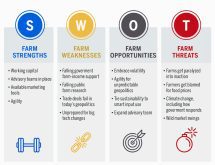Typically banks review their clients’ financial statements annually as part of a credit review process. The goal is to understand the client’s ability to service debt and how this may have changed over the past year.
“We want to help you manage your cash flow,” says plain speaking Tara Conway, BMO vice-president of commercial banking in Brantford, Ont.
“Properly structured debt, plus ongoing reviews and updates of business plans can help you and our bank always know your financial capacity in case of buying opportunities or changes, or simply have a handle on the financial position of your farm,” Conway says.
Read Also

The big squeeze: How to be fair to siblings during farm succession
Managing sibling business relationships on family farms.
Getting that clear picture takes more than dropping off a copy of your year-end statement for a standard review process, Conway says.
So exactly what do bankers want to know about you and your farm?
Stage of business
Conway wants to know where the farm business is in its life cycle.
There’s the startup phase, which has high failure rates. Income at this stage is tight, and management is highly variable between operations.
Or you could be in the growth stage, during which management is increasing rapidly but there may still be a lack of capital to operate and expand.
Or your farm business might be in the mature stage, when it has sufficient assets, and might even be downsizing or considering succession.
Knowing the stage can help the lending institution have a clearer picture of the entire situation, including who’s involved at arm’s-length and if there’s off-farm income.
Also your banker might help you source non-traditional capital through the Canadian Agricultural Loans Act (CALA), a federal government program that provides guarantees for starting farmers.
What do I need in my business plan?
“More information is better,” says Conway.
In addition to budgets and cash-flow projections for the coming year, include strategies for growth, what challenges and opportunities might lie ahead, and any next steps that are in the works for the future.
Business plans should be annually reviewed and updated. “Keep it alive,” says Conway.
How much debt can your farm handle?
Nicole Clement from RBC in Embrun, Ont., calculates the client’s debt service coverage (DSC) ratio. To do this, she takes the year’s net operating income or EBITDA (earnings before interest, taxes, depreciation and amortization) and divides it by total debt obligations.
“This will tell you how much residual income is available to cover payments,” says Clement, whose clients are mainly dairy or cash crop producers. “As a rule of thumb, the DSC ratio should be at least 1.2:1.” This suggests there’s a bit of a cushion, in case next year’s revenue comes in lower, or expenses higher, than the producer foresees.
As well, the general liquidity of the business is something you should calculate and share with your banker as it gives an idea of the farm’s ability to pay back its liabilities with the sale of its assets. Current ratio is current assets divided by current liabilities. Working capital is current assets minus current liabilities.
Also, your personal credit scores are important, says Conway. So make sure you’re paying off your credit cards. For a minimal fee you can check your personal credit score on sites such as Equifax.
“Right now a good credit rating is about 700,” says Conway.
Furthermore, Conway says your farm should limit the amount of credit card liability it is carrying, and keep credit cards paid off monthly so you aren’t getting hit with high interest rates.
Net worth statement
Include an up-to-date net worth statement with your business plan. You can download a fill-in-the-blank net worth statement complete with inventory at on the Manitoba Agriculture website by searching for “analyzing a farm business.”
Conway says you should also include a personal net worth statement, including off-farm investments: “It indicates the ability to inject cash into a business.”
How do you manage risk?
Included in your business plan should be a market outlook for the next year and long-term for all the products you grow on your farm.
Also, you should include in your business plan how your farm hedges prices of inputs and sales, and how it manages production risks. Include whether you belong to programs like Agristability or use production insurance, says Conway.
Be aware that crop insurance coverage can be considered as inventory for security.
Cash-flow projections
Is your debt properly structured to handle any projected capital expenditures in the next 18 months? What is the ratio between fixed and variable rate loans?
Do you have a line of credit or are you using credit cards as operating lines?
Are you using short-term loaning structures to buy longer-term assets like machinery?
There are a few other programs that can help with buying inputs such as the newly revised Advance Payments Program. APP is a federal loan guarantee program which provides agricultural producers with easy access to low-interest cash advances. Under the program, producers can access up to $400,000 per program year in advances based on the value of their agricultural product, with the Government of Canada paying the interest on the first $100,000 advanced to a producer.
Advances are repaid as the farmer sells the agricultural product, with up to 18 months to fully repay the advance for most commodities (up to 24 months for cattle and bison).
Another idea that can help with cash flow is setting up online banking with automatic deposits and payments as well as being able to scan and deposit cheques directly into your farm account instead of having to make a trip to the bank to deposit them.
Credit ready?
You should have a good handle on how your debt is structured. What is your ratio of variable to fixed interest loans? This can lead to an interesting discussion about length of terms, your acceptable risk level, and interest rates.
Taking FCC’s lead, more lending agencies have created packages of ready-to-use credit, just in case a buying opportunity comes your way and you need to move quickly.
If your bank knows your potential future plans, you can actually put the credit space into place.















